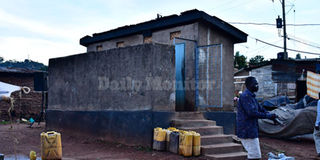1,500 slum dwellers sharing three toilets

A man walks past one of the public pit-latrines in Kasanvu Zone, Makindye Division in Kampala, yesterday. PHOTO/ABUBAKER LUBOWA
What you need to know:
- The shortage of toilets, fee to access them amid high poverty levels and distance of the latrines, have made residents to resort to open defecation.
More than 1,500 residents of Kasanvu, a slum in Namuwongo, a Kampala suburb, share three community pit-latrines, with four stances, Daily Monitor has established.
The shortage of toilets, fee to access them amid high poverty levels and distance of the latrines, have made residents to resort to open defecation.
“We are having many cases of diarrhoea and other water-borne diseases because government has not allowed owners of rentals to construct latrines,” Ms Dolphin Atieno, a resident, who doubles as a caretaker of one of the rentals, says.
“Most people are defecating in open places or they use polythene bags and then dump in the trenches. But some people use the community toilets,” Ms Atieno, who has lived in the area for more than five years, says.
Despite being at the heart of the capital city, stench and flies welcome passersby.
Ms Jacqueline Nantongo, a clinic operator, says most patients, especially children, suffer from diarrhoea due to poor hygiene, adding that most dwellers also collect water from wells.
Ten other families, each having around five members, who are renting at the semi-permanent premise where Atieno and her four children reside, are entangled in this poor sanitary condition.
“The local council chairman doesn’t allow us to construct toilets here. If they hear a rumour that someone is constructing a latrine, they come and attack them,” Ms Atieno says.
She anticipates that the leaders want people to pay in order to access a public toilet, which was constructed through a public-private partnership.
The toilet is about 100 metres away from Atieno’s rental and for other residents, it is more than 300 metres away.
A visit by this reporter on May 4, although inside the toilet was relatively clean, there was neither soap nor water for handwashing.
Mr Richard Byibesho, the village chairperson, says: “Many people from neighbouring communities also come to the same toilet.”
However, the toilet attendance was not overwhelming. Ms Atieno reasons that with high level of unemployment, and poverty, which has been worsened by the effects of the Covid-19, a few people can afford using public toilets.
KCCA says
Dr Dan Okello, the head of public health services at Kampala Capital City Authority (KCCA), says they stopped the construction of toilets because the place is in a swampy area.
“We have had two incidences of cholera outbreak in Kasanvu. If you see the area, it is swampy and so if you construct a toilet, you will pollute the area (with human waste). So, we are going to put up community toilet at a point that is safe so that people can use,” he said.
But a deeper investigation indicates that some homes are defying the rules of not constructing temporary latrines in the swampy area at the rear corners of their homes and the wastes are released into the trenches.
Who recommends
Toilets should be at a minimum distance of six metres from one’s house so that it is easy to reach during bad weather or during the night, according to World Health Organisation (WHO). WHO discourages community toilets because they tend to be unhygienic, recommending a toilet per household.




